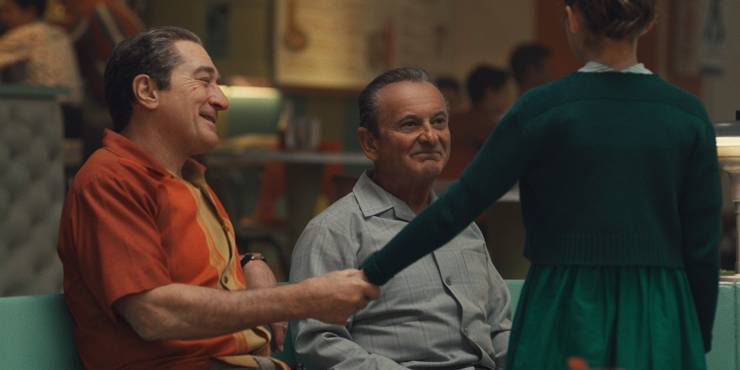WARNING: Spoilers for The Irishman.
In The Irishman, Joe Pesci and Robert De Niro portray real-life criminals associated with the Bufalino crime family. Martin Scorsese’s Netflix film is based on the Charles Brandt book, I Heard You Paint Houses; Brandt based his nonfiction book on the confessions of Frank Sheeran, an alleged mafia hitman for the Bufalino crime family, who claimed responsibility for the murder of Jimmy Hoffa. However, Hoffa’s disappearance was never officially solved by the FBI: no charges were ever laid for his murder, and he was declared dead in absentia. Given the nature of its source material, is Scorsese’s The Irishman the true story behind the Bufalino crime family and Hoffa’s death? How powerful was the real-life Bufalino family?
The Irishman frames Russell Bufalino (Pesci) as a quiet-spoken Pennsylvania mob boss who introduces hitman Frank Sheeran (De Niro) to the infamous Jimmy Hoffa (Al Pacino). The storyline explores how Sheeran learns the rules of the criminal underworld, and how men like Bufalino and Hoffa sustain (or damage) relationships with influential figures. In this story, drawing from Brandt’s book, Bufalino ordered Sheeran to permanently silence Hoffa in order to protect his on-going business relationships. Bufalino steadily reminds Sheeran about the larger picture, one that Hoffa presumably failed to understand.
In real life, Bufalino was indeed a powerful mob boss. The Bufalino crime family is an extension of the Northeastern Pennsylvania crime family, but it’s named after Russell himself. Bufalino’s ascension within the criminal underworld dates back to the infamous 1957 Apalachin Meeting, in which various mafia figures assembled at the home of Northeastern Pennsylvania crime family boss Joseph “Joe the Barber” Barbara, only to be raided by law enforcement officials. Barbara passed away two years later from a heart attack, allowing his underboss — Bufalino, a fellow Sicilian-American and long-time associate — to assume control.

The Irishman, which uses CGI deaging technology, portrays Bufalino and Sheeran at different stages in their lives; however, it doesn’t acknowledge a pivotal moment in Bufalino’s backstory. In 1963, he was publicly named, in court, by gangster-turned-informant Joseph Valachi; a moment that forever changed the perception of the mafia in American culture. In Scorsese’s film, when Sheeran befriends Bufalino, he doesn’t fully realize how much power the man has. The titular Irishman is then immersed into Bufalino’s world, and everything becomes clear. The rest of The Irishman connects to popular conspiracy theories, most notably the idea that Bufalino was part of a CIA plot to assassinate Cuban leader Fidel Castro, and perhaps even involved with John F. Kennedy’s assassination.
Bufalino had immense power during the ‘70s, not only because he was so careful, but also because he quietly took on more responsibilities while other crime families worked through internal issues. Thus, The Irishman’s narrative aligns with history in depicting how American mobsters communicated with politicians during the ’60s and ’70s. However, just two years after Hoffa went missing in 1975, real-life Bufalino was arrested for extortion after threatening a government witness. He later spent the majority of the ‘80s at Leavenworth prison, and spent the last five years of his life as a free man.
The Irishman is full of references for fans of the genre to parse out. It features a sequence in which Bufalino orders Sheeran to murder Joey Gallo: an infamous mob hit that remains officially unsolved. In the 1990 Scorsese classic Goodfellas, both Bufalino and Gallo are referenced during Henry Hill’s narration when he states that “It was a glorious time. Wise guys were all over the place. It was before Apalachin and before Crazy Joe decided to take on a boss and start a war.” Ironically, the Bufalino and Gallo references directly precede the introduction of Jimmy “The Irishman” Conway, portrayed by none other than De Niro. It’s references like these throughout The Irishman that acknowledge not just the history of the Mafia, but the history of great Mafia films.
About The Author




